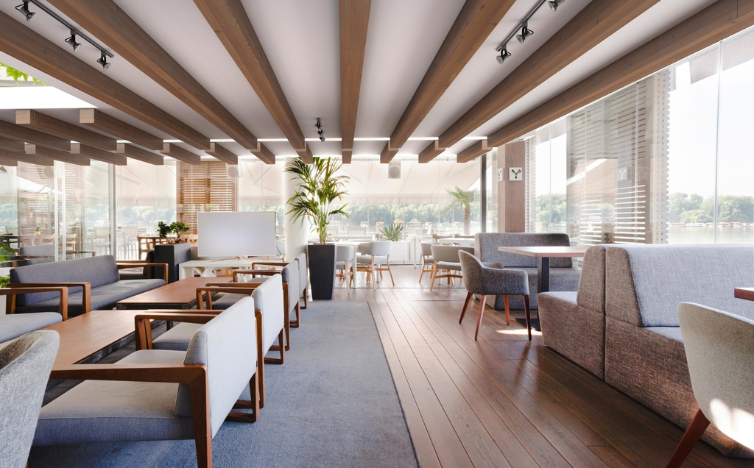Noise management is crucial for restaurants aiming to provide a pleasant dining experience. Excessive noise can make conversations challenging, disrupt ambiance, and deter customers from returning. This guide explores practical acoustic tips for restaurants for managing noise.
1. Identify Noise Sources
Understanding the primary noise sources in your restaurant helps in creating effective sound control measures. Common sources include:
- Customer Conversations: In high-traffic times, overlapping conversations raise noise levels.
- Kitchen Sounds: Clanging pans, hissing steam, and loud appliances add to the overall noise.
- Background Music: While it enhances ambiance, loud music can add to the chaos.
By identifying these sources, you can apply targeted acoustic treatments to specific areas that contribute most to the noise level.
2. Use Sound-Absorbing Materials
One of the simplest ways to control noise is to incorporate materials that absorb sound effectively. These materials reduce echo and reverberation, allowing for a quieter atmosphere.

- Ceiling Panels: Acoustic ceiling panels capture sound waves and prevent them from bouncing around.
- Wall Treatments: Installing acoustic panels or fabric-wrapped boards on walls can minimize noise reflections.
- Soft Furnishings: Adding carpets, curtains, or cushioned seating reduces the impact of sound on hard surfaces.
By strategically placing sound-absorbing materials in areas where sound is most likely to bounce, you can significantly reduce noise.
3. Consider Acoustic Dividers for Open Spaces
In open-plan dining areas, sound easily travels from one end to another. Acoustic dividers, like partition walls or soundproof booths, create smaller sections that help contain noise.
- Partition Walls: These can visually and acoustically separate sections within a dining area.
- Plants and Green Walls: Greenery acts as a natural sound buffer while enhancing aesthetics.
Dividers not only reduce the overall noise but also give a sense of privacy, enhancing the dining experience.
4. Control Background Music Volume
Music can make or break a restaurant’s atmosphere. It’s important to control the volume carefully, especially during busy times.
- Smart Sound Systems: Use sound systems that adjust volume levels based on ambient noise.
- Designated Speaker Zones: Place speakers strategically to ensure even music distribution without increasing volume unnecessarily.
Balanced music levels can mask background noise while maintaining a comfortable atmosphere for diners.
5. Optimize Furniture and Layout
Restaurant furniture and layout impact acoustics. Choosing the right furniture and arranging it thoughtfully helps manage noise.
- Soft, Cushioned Seating: Furniture with soft upholstery absorbs more sound, reducing noise.
- Spacing Between Tables: Keep adequate space between tables to avoid overcrowding and excessive noise.
A well-planned layout minimizes sound reflection and makes conversations easier for diners.
6. Utilize Acoustic Ceilings
High ceilings can create excessive echo and amplify noise. Acoustic ceiling solutions, such as hanging baffles or clouds, are effective at absorbing sound in these spaces.
- Hanging Baffles: These are vertical panels that hang from the ceiling, capturing sound waves.
- Ceiling Clouds: Flat acoustic panels suspended from the ceiling absorb sound from all directions.
These ceiling solutions are particularly effective for high-ceilinged restaurants with significant reverberation issues.
7. Train Staff on Noise Awareness
Staff can help manage noise levels by being mindful of their actions and interactions. Simple adjustments, like keeping voices down when interacting near tables, can make a big difference.
- Service Training: Train staff to be aware of noise created by actions like stacking plates or moving chairs.
- Encourage Efficient Communication: Encourage staff to use hand signals or minimize loud calls across the room to reduce noise during service.
When staff are mindful of noise, they can significantly contribute to a quieter dining environment.
8. Consider Acoustic Flooring Options
Hard flooring, like tile or concrete, reflects sound, contributing to noise levels. Acoustic flooring options can help absorb sound and reduce noise from footsteps and chair movement.
- Cork Flooring: Cork is a natural sound absorber and adds a warm, cozy feel to the restaurant.
- Rubber Mats: Placing rubber mats in areas with heavy foot traffic, such as near the kitchen, reduces noise from footsteps.
Incorporating softer materials into the flooring design creates a quieter environment without compromising on aesthetics.
Call us: Contact DeSound Soundproofing Expert in Dubai For Soundproofing: +971 56 231 4204
Final Thoughts
Managing noise in a busy restaurant is essential for creating a comfortable and enjoyable dining experience. By integrating sound-absorbing materials, optimizing layouts, and training staff, restaurant owners can effectively control noise. Implementing these acoustic strategies will not only improve customer satisfaction but also set a relaxing atmosphere that encourages guests to return.

